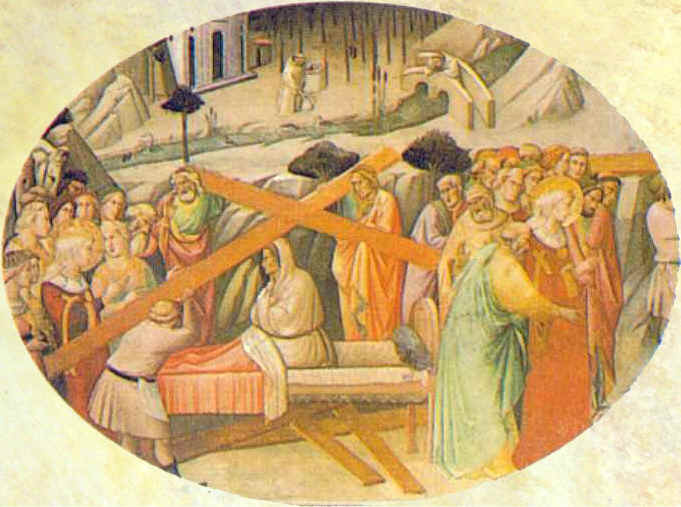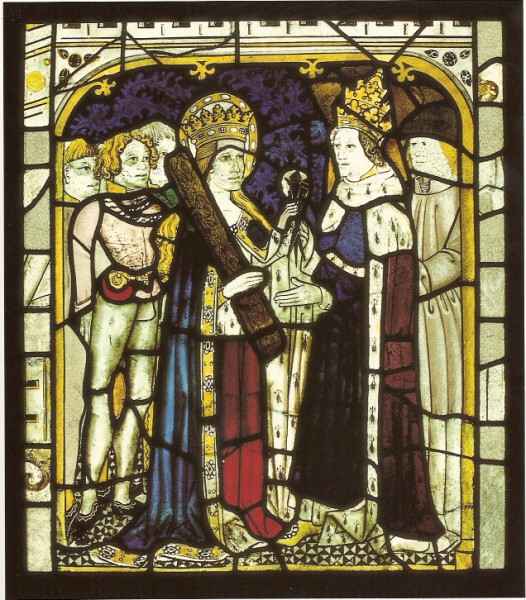
It was most just that our Divine King should show Himself to us with the scepter of His power, to the end that nothing might be wanting to the majesty of His Empire. This scepter is the Cross; and Paschal Time was to be the Season for its being offered to Him in glad homage. A few weeks back, and the Cross was shown to us as the instrument of Our Lord's humiliation and as the bed of suffering whereon He died; but has He not since then conquered Death? And what is His Cross now but a trophy of His victory? Let It then be brought forth to our gaze and let every knee bend before this sacred Wood, whereby our Jesus won the honor and praise we now give Him!
On the day of His birth at Bethlehem we sang these words of the Prophet Isaias: A Child is born unto us, and a Son is given unto us, and His government is upon His shoulder (Is. 9: 6). We have seen Him carrying this Cross upon His shoulder; as Isaac carried the wood for his own immolation; but now It is no longer a heavy burden. It is shining with a brightness that ravishes the eyes of the angels; and after having received the veneration of man as long as the world lasts, It will suddenly appear in the clouds of Heaven, near the Judge of the living and the dead–a consolation to them that have loved It, but a reproach to such as have treated It with contempt or forgetfulness.
Our Savior did not think the time between His Resurrection and Ascension a fitting one for glorifying the instrument of His victory. The Cross was not to be brought into notice until It had subjected the world to Him whose glory It so eloquently proclaimed. Jesus was three days in the tomb; His Cross is to lie buried, unknown to men, for three centuries: but It is to have Its resurrection, and the Church celebrates this resurrection today. Jesus would, in His own good time, add to the joy of Easter by miraculously revealing to us this sacred monument of His love for mankind. He entrusts It to our keeping; It is to be our consolation as long as this world lasts: is it not just that we should love and venerate It?
Never had Satan's pride met with such a humiliation as when he saw the instrument of our perdition made the instrument of our salvation. As the Church expresses it in Her Preface for Passiontide: "He that overcame mankind by a Tree, was overcome by a Tree." Thus foiled, he vented his fury upon this saving Wood, which so bitterly reminded him both of the irresistible power of his Conqueror and of the dignity of man who had been redeemed at so great a price. He would fain have annihilated the Cross; but knowing that this was beyond his power, he endeavored to profane It, and hide It from view. He therefore instigated the Jews to bury It. At the foot of Calvary, not far from the sepulcher, was a deep hole. Into this was the Cross thrown, together with those of the two thieves, the Nails, the Crown of Thorns, and the Inscription or Title written by Pilate. The hole was then filled up with rubbish and earth, and the Sanhedrim exulted in the thought of its having effaced the memory of the Nazarene, Who could not save Himself from the ignominious death of the Cross.
Forty years after this, Jerusalem was destroyed by the Romans, the instruments of God's vengeance. The Holy Places were desecrated by the idolaters. A small temple to Venus was erected on Calvary, and another to Jupiter over the Holy Sepulcher. By this, the pagans intended derision; whereas, they were perpetuating the knowledge of the two spots of most sacred interest. When peace was restored under Constantine, the Christians had but to remove these pagan monuments, and their eyes beheld the holy ground that had been bedewed with the Blood of Jesus, and the glorious Sepulcher. As to the Cross, It was not so easily found. The scepter of our Divine King was to be raised up from its tomb by a royal hand. The saintly Empress Helena, Constantine's mother, was chosen by Heaven to pay to Jesus–and that, too, on the very spot where He had received His greatest humiliations–the honors which are due to Him as the King of the world. Before laying the foundations of the Basilica of the Resurrection, this worthy follower of St. Mary Magdalen and the other holy women of the Sepulcher was anxious to discover the Instrument of our salvation. The Jews had kept up the tradition of the site where It had been buried: the Empress had the excavations made accordingly. With what holy impatience she must have watched the works, and with what ecstasy of joy did she behold the redeeming Wood, which, though not at first distinguishable, was certainly one of the three Crosses that were found! She addressed a fervent prayer to the Savior, Who alone could reveal to her which was the trophy of His victory; the Bishop, Macarius, united his prayers to hers; and their faith was rewarded by a miracle that left them no doubt as to which was the true Cross.

The glorious work was accomplished, and the Church was put in possession of the instrument of the world's Redemption. Both East and West were filled with joy at the news of this precious discovery, which Heaven had initiated, and which gave the last finish to the triumph of Christianity. Christ completed His victory over the pagan world by raising thus His standard–not a figurative one, but His own real standard–His Cross, which, up to that time, had been a stumbling-block to the Jews, and foolishness to the Gentiles; but before which every Christian is henceforth to bend his knee.
St. Helena placed the Holy Cross in the Basilica which had been built by her orders, and which covered both the glorious Sepulcher and the hill of the Crucifixion. Another Church was erected on the site where the Cross had lain concealed for 300 years, and the faithful were enabled, by long flights of steps, to go down into the deep grotto, which had been Its tomb. Pilgrims came from every part of the world to visit the hallowed places where our Redemption had been wrought, and to venerate the sacred Wood of the Cross. But God's merciful providence willed not that the precious pledge of Jesus' love for mankind should be confined to one sanctuary only, however venerable it might be. Immediately after its discovery, St. Helena had a very large piece cut from the Cross; and this fragment she destined for Rome, the new Jerusalem. The precious gift was enshrined in the Basilica built by her son Constantine in the Sessorian garden, which was afterwards called the Basilica of The-Holy-Cross-in-Jerusalem.

By degrees, other places were honored by the presence of the Wood of the Holy Cross. So far back as the 4th century, we have St. Cyril of Jerusalem attesting that many of the pilgrims used to obtain small pieces of It, and thus carried the precious treasure into their respective countries; and St. Paulinus of Nola, who lived in the same century, assures us that these many gifts lessened not the size of the original relic. In the 6th century, the holy Queen St. Radegonde obtained from the Emperor Justin II a large piece from the fragment that was in the imperial treasury of Constantinople. It was for the reception of this piece of the True Cross into France that Venantius Fortunatus composed the Vexilla Regis-that beautiful hymn which the Church uses in Her Liturgy as often as She celebrates the praise of the Holy Cross. After several times losing and regaining It, Jerusalem was at length forever deprived of the precious relic. Constantinople was a gainer by Jerusalem's loss. From Constantinople, especially during the Crusades, many churches of the West procured large pieces. These again supplied other places; until at length the Wood of the Cross was to be found in almost every town of any importance. There is scarcely to be found a Catholic who, sometime or other in his life, has not had the happiness of seeing and venerating a portion of this sacred object. How many acts of love and gratitude have not been occasioned by this? And who could fail to recognize, in this successive profusion of our Jesus' Cross, a plan of Divine Providence for exciting us to us appreciation of our Redemption, on which rest all our hopes of eternal happiness?
How dear, then, to us should this day be, which blends together the recollection of the Holy Cross and the joys of the Resurrection of that Jesus Who by the Cross has won the throne to which we shall soon see Him ascend! Let us thank our Heavenly Father for His having restored to mankind a treasure so immensely precious as is the Cross. Until the day comes for It to appear with Himself in the clouds of Heaven, Jesus has entrusted It to His Spouse. He will collect together all the fragments by His divine power; and the Tree of Life will then gladden the elect with Its dazzling beauty, and invite them to eternal rest beneath Its refreshing shade.
The Liturgy gives us the following history of the great event we are celebrating today:
After the great victory gained over Maxentius by the Emperor Constantine, under the standard of Our Lord's Cross, which had been miraculously shown to him, St. Helena, his mother, was told in a dream to repair to Jerusalem and search for the true Cross. Upon her arrival, she ordered to be taken down a marble statue of Venus, which had been erected by the Pagans some 180 years before, in order that all memory of Our Lord's Passion might be obliterated. She did the same service for the place where reposed the Savior's crib, as also for the site of the Resurrection: removing from the former an idol of Adonis, and from the latter an idol of Jupiter.
The place where the Cross was believed to be having been excavated, three crosses were discovered at a great depth below the surface; and with them, though not attached, the Title that had been fastened to Our Lord's Cross. The doubt as to which of the three crosses the Title belonged was removed by a miracle. After having prayed to God, Macarius, the Bishop of Jerusalem, applied each of the crosses to a woman who was afflicted with a dangerous malady. The first two produced no result; the third was applied and the woman was restored to perfect health.
The Holy Cross being thus found, St. Helena built a magnificent Church in Jerusalem, in which she placed a portion of the Cross, enshrined in a silver case: the remaining part she took to her son Constantine, and It was put in the Church called The-Holy-Cross-in-Jerusalem, which was built on the site of the Sessorian palace [in Rome]. She also took to her son the Nails wherewith the Most Holy Body of Jesus Christ had been fastened to the Cross. Constantine passed a law that from that time forward a cross should never be used as an instrument of punishment; and thus what hitherto had been an object of reproach and derision became one of veneration and glory.
Contact us: smr@salvemariaregina.info
Visit also: www.marienfried.com